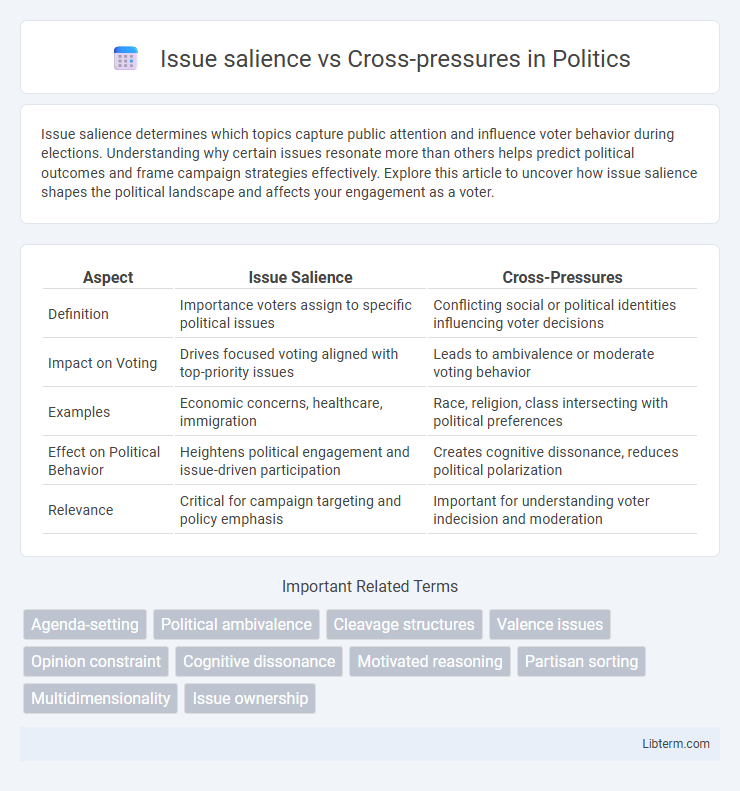Issue salience determines which topics capture public attention and influence voter behavior during elections. Understanding why certain issues resonate more than others helps predict political outcomes and frame campaign strategies effectively. Explore this article to uncover how issue salience shapes the political landscape and affects your engagement as a voter.
Table of Comparison
| Aspect | Issue Salience | Cross-Pressures |
|---|---|---|
| Definition | Importance voters assign to specific political issues | Conflicting social or political identities influencing voter decisions |
| Impact on Voting | Drives focused voting aligned with top-priority issues | Leads to ambivalence or moderate voting behavior |
| Examples | Economic concerns, healthcare, immigration | Race, religion, class intersecting with political preferences |
| Effect on Political Behavior | Heightens political engagement and issue-driven participation | Creates cognitive dissonance, reduces political polarization |
| Relevance | Critical for campaign targeting and policy emphasis | Important for understanding voter indecision and moderation |
Introduction to Issue Salience and Cross-Pressures
Issue salience refers to the importance or prominence of specific political issues to voters, shaping their electoral decisions based on the issues they prioritize most. Cross-pressures occur when voters experience conflicting cues from their party identification, social groups, or issue preferences, leading to ambivalence or divided political loyalties. Understanding the interplay between issue salience and cross-pressures helps explain variations in voter behavior and electoral outcomes.
Defining Issue Salience: Importance in Political Behavior
Issue salience refers to the degree to which specific political issues are perceived as important by individuals within the electorate, directly influencing voter priorities and decision-making processes. High salience issues, such as economic stability or healthcare reform, tend to dominate public discourse and shape voting behavior by aligning with voters' core policy concerns. Understanding issue salience is crucial for analyzing political behavior because it reveals how certain topics mobilize voter engagement and impact party support amid competing cross-pressures from conflicting social identities or values.
Understanding Cross-Pressures: Conflicting Social Influences
Cross-pressures arise when individuals face conflicting social influences from multiple identity groups, such as family, religion, or political affiliation, creating tension in decision-making. These opposing pressures can reduce issue salience by diluting the clarity and priority of specific political or social issues, leading to ambivalence or moderated views. Understanding cross-pressures helps explain why voters or citizens often exhibit complex and inconsistent behavior on key topics despite strong personal or group attachments.
Historical Context: Evolution of Issue Salience and Cross-Pressures
Issue salience and cross-pressures have evolved significantly since the mid-20th century, reflecting changes in political polarization and voter behavior. Historically, issue salience referred to the prominence of specific political topics that heavily influenced voter decisions, while cross-pressures emerged as conflicting social identities or values within individuals that complicated straightforward voting patterns. The increasing complexity of political issues and the diversification of social factors over time have intensified cross-pressures, leading to more nuanced and less predictable electoral outcomes.
Mechanisms: How Issue Salience Shapes Voter Decisions
Issue salience directs voter attention by prioritizing specific topics that align with their core concerns, enhancing cognitive engagement and reducing information overload. Cross-pressures emerge when conflicting issue priorities challenge consistent party alignment, compelling voters to reconcile divergent values or interests. Mechanisms such as selective exposure and motivated reasoning enable voters to interpret information in ways that reinforce salient issues while managing cross-pressures to maintain coherent political choices.
Cross-Pressures and Voter Ambivalence
Cross-pressures occur when voters face conflicting influences from their social groups, political beliefs, or personal interests, creating voter ambivalence and reducing partisan certainty. This internal conflict complicates decision-making, often leading to split-ticket voting or lower voter turnout. Understanding cross-pressures is essential for analyzing voter behavior and predicting electoral outcomes in pluralistic societies.
Interaction Between Issue Salience and Cross-Pressures
Issue salience intensifies voter sensitivity to specific political topics, while cross-pressures arise when individuals face conflicting influences from different social or political groups. The interaction between issue salience and cross-pressures shapes decision-making by heightening cognitive dissonance when a highly salient issue clashes with opposing group loyalties. This dynamic often leads to nuanced voting behavior, where heightened awareness of key issues complicates the resolution of conflicting pressures.
Empirical Evidence: Case Studies and Key Findings
Empirical evidence from case studies on issue salience versus cross-pressures reveals that voters prioritize specific policy issues based on their personal relevance and social context, often leading to conflicting political preferences. Research demonstrates that when individuals face cross-pressures from their social groups and ideological beliefs, issue salience intensifies the cognitive dissonance and can influence voting patterns and political engagement. Key findings indicate that high issue salience moderates the impact of cross-pressures, resulting in selective attention to congruent information and increased likelihood of partisan reinforcement.
Implications for Political Campaign Strategies
Issue salience shapes voter priorities by highlighting specific topics, while cross-pressures create conflicting loyalties that complicate voter decisions. Political campaign strategies must tailor messaging to amplify salient issues that resonate with target demographics, thereby reducing the impact of cross-pressures. Effective segmentation and targeted communication enhance voter alignment and increase campaign efficacy in competitive electoral environments.
Conclusion: Navigating Issue Salience and Cross-Pressures in Modern Politics
Navigating issue salience and cross-pressures in modern politics requires understanding how prominent issues shape voter priorities while conflicting identities create cognitive dissonance. Political campaigns must strategically emphasize salient topics that resonate with core values to mitigate the impact of cross-pressures arising from overlapping group affiliations. Effective messaging balances issue salience to reinforce partisan alignment and addresses cross-pressures to reduce voter ambivalence, thereby enhancing electoral coherence.
Issue salience Infographic

 libterm.com
libterm.com